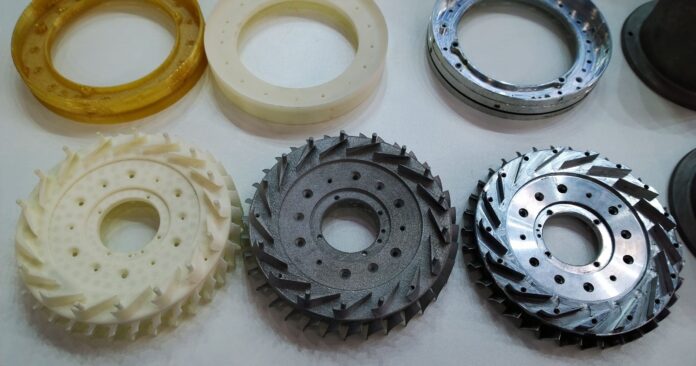Jaymes Kine, writing for Massivit 3D, surveys the types of 3D printing materials used for industrial purposes, along with their pros and cons.
3D printing, also called additive manufacturing, has revolutionised the manufacturing industry by enabling the production of complex designs in a range of materials. In fact, while we typically focus on technological advancements of 3D printers themselves, a great deal of the innovation we are seeing today is driven by advancements in printing materials. There is no ‘one size fits all’ either, so it is important for companies to understand which materials would best create the product they are looking to 3D print. While this undoubtedly could take some trial and error, knowing what is out there is a good place to start.
Plastic 3D printing materials
Plastic is one of the most common materials used in 3D printing. It is lightweight, durable, and can be used for a wide range of industrial applications, including aftermarket parts, medical equipment, and consumer goods. The most commonly used plastic material for 3D printing is called acrylonitrile butadiene styrene (ABS). It is easy to print with, has good mechanical properties, and is resistant to impact and heat.
Another popular plastic material is called polylactic acid (PLA), which is made from renewable resources such as cornstarch or sugarcane. PLA is easy to print with and biodegradable, making it a popular choice for eco-friendly applications.
Pros: lightweight, somewhat durable, wide range of industrial applications, good mechanical properties, and biodegradable are options available.
Cons: limited strength and heat resistance compared to other materials, can warp or deform when exposed to high temperatures, slow to produce due to lengthy process of heating to melting point and then cooling, and usually limited by the size of printed pieces.
Metal 3D printing materials
Metal 3D printing is becoming increasingly popular in industrial settings due to its strength, durability, and high-temperature resistance. This type of additive manufacturing is ideal for applications such as certain automotive parts as well as a variety of medical devices. The most commonly used metal materials for 3D printing include stainless steel, titanium, aluminum and nickel alloys. Metal 3D printing can be accomplished using different methods such as powder bed fusion, binder jetting, and directed energy deposition.
Pros: strong and durable, high-temperature resistance, and ideal for aerospace and medical applications.
Cons: expensive, heavy – thus pricey to ship, limited availability of metal powders for printing, slower print times and a more complex printing process, and lack of flexibility means no complex geometric shapes.
Ceramic 3D printing materials
Ceramic materials have high-temperature and chemical resistance, making them great for industrial and aerospace applications. They can create intricate shapes and geometries. The most commonly used ceramic materials for 3D printing include zirconia, alumina, and silica. Ceramic 3D printing can be accomplished using different methods such as binder jetting, powder bed fusion, and vat photopolymerisation.
Pros: high-temperature and chemical resistance, ideal for industrial and aerospace applications, and the ability to create intricate shapes and geometries.
Cons: limited availability of ceramic powders for printing, requires special handling and firing processes after printing, and can be brittle and prone to cracking.
Composite Materials
Composite materials, such as carbon fibre, Kevlar, and fibreglass, are materials that combine two or more different materials to create a new material with enhanced properties. Composite material production parts are widely used in a range of industrial applications including aerospace, automotive, marine, consumer goods, and sporting goods due to their superior mechanical properties and optimal balance of being lightweight yet stiff and strong. Composite material components have traditionally been produced using molds. There are ongoing concerted efforts to develop 3D printers that can directly 3D print composite materials for real world applications.
Pros: enhanced properties such as strength, stiffness, lightness and durability; ideal for aerospace, automotive, consumer goods, and sporting goods applications.
Cons: can be expensive, limited availability of composite materials for printing, slower print times and a more complex printing process.
Note: even if composite parts aren’t directly printed, additive manufacturing can greatly speed up production by printing an industrial mould for these parts (also mentioned below under ‘gel-based materials’).
Bio-based 3D printing materials
Bio-based materials are 3D printing materials made from renewable resources such as starch, sugar and cellulose. They are biodegradable and can be used in a range of applications such as packaging, toys and medical devices. The most commonly used bio-based material for 3D printing is called polyhydroxyalkanoate (PHA), which is biodegradable, has good mechanical properties, and is easy to print with.
Pros: made from renewable resources, biodegradable, good mechanical properties, and can be used in a range of applications
Cons: limited availability of bio-based materials for printing, can be more expensive than traditional plastics and limited temperature resistance.
Gel-based 3D printing materials
Gel-based materials are a newer addition to the range of materials used for industrial 3D printing.
Pros: capable of producing large-scale items, faster printing times and more efficient than traditional materials, and materials with varying properties such as high HDT and translucency are available.
Cons: gel-based materials are relatively new and not always understood.
What’s right for your business?
The range of 3D printing materials available for industrial purposes is constantly expanding. Each material has its own unique set of properties and applications, and choosing the right material for a specific project requires careful consideration of the material’s strengths and limitations. By staying up to date with the latest developments in 3D printing technology, manufacturers can take full advantage of the benefits offered by 3D printing to produce high-quality, complex designs in a range of materials.
MASSIVIT 3D
https://massivit3d.com















